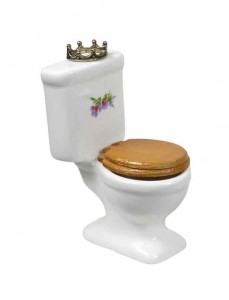The History of the Toilet
 The modern conception of the toilet is a relatively recent innovation. Existing primarily indoors with a sanitary flushing mechanism, the toilet is a convenient feature of almost every building in the modern world.
The modern conception of the toilet is a relatively recent innovation. Existing primarily indoors with a sanitary flushing mechanism, the toilet is a convenient feature of almost every building in the modern world.
However, this widespread convenience has actually existed since ancient days in one primitive form or another.
The toilet has evolved slowly over time to its current form from a system of clay pots connected to pipes that the ancient Greeks employed thousands of years ago, to the first documentation of indoor plumbing in 1820s Boston.
Disposing of waste has always been a necessary concern in human societies, therefore various forms of the toilet can be found throughout most major civilizations in human history.
Ancient Toilets
The earliest records of toilets come from both the ancient Greeks and the ancient Scots. Excavations of dwellings in both Greece and Scotland show evidence of crude, yet sophisticated for the time, toilet alcoves in walls that connected to clay piping. These primitive toilet structures are not found anywhere else on the European continent until the ascension of ancient Rome.
Ancient Roman cities had impressive sanitation systems. Their public bathrooms were huge and could actually host many people in one room.
Their toilets were placed right next to each other along benches. These bathrooms were connected to a sewer system which carried the waste away from the cities.
Medieval Toilets
The evolution of the toilet regressed during the Middle Ages. Most people simply utilized a hole in the ground or a vessel called a “chamber pot”.
Some medieval castles were outfitted with “garderobes” which featured seats cut in to vertical shafts through which waste was deposited. This system lasted until the invention of the first flushing toilet in the late 1500s.
 Modern Toilets
Modern Toilets
The first flushing toilet incorporated a valve that released water into a waste-collecting vessel and then flushed the waste down a pipe.
This invention was improved upon and various features were added such as the s-shaped base pipes and water tanks that are standard to toilets today.
The first indoor toilets were recorded in the early 1800s. Due to the initial cost of installation however, indoor plumbing did not become widespread until the 1900s.
During the 1900s, toilets continued to be improved upon. They were made more compact and water efficient. Today, in the developed world, most buildings boast clean and efficient toilets that provide convenient sanitation for our societies.
If you live in the Naperville area, and are having toilet troubles, Call Jim Wagner Plumbing at (630) 577-9241 and find out how you can get your toilet back!
